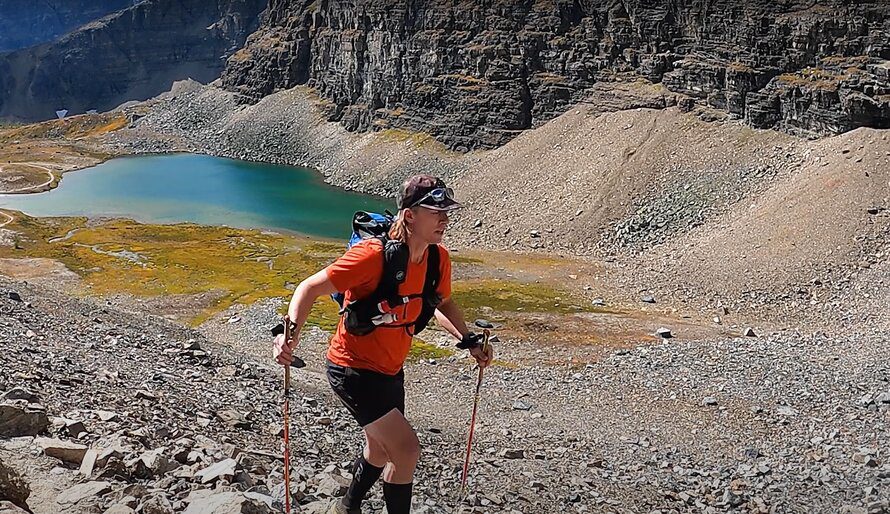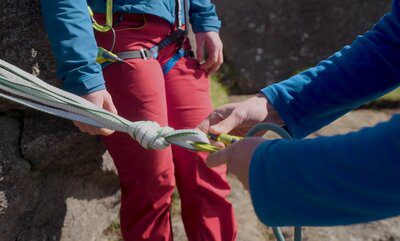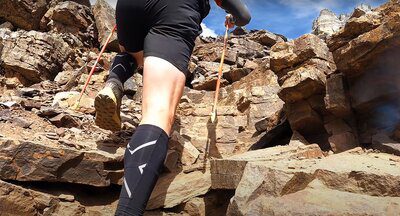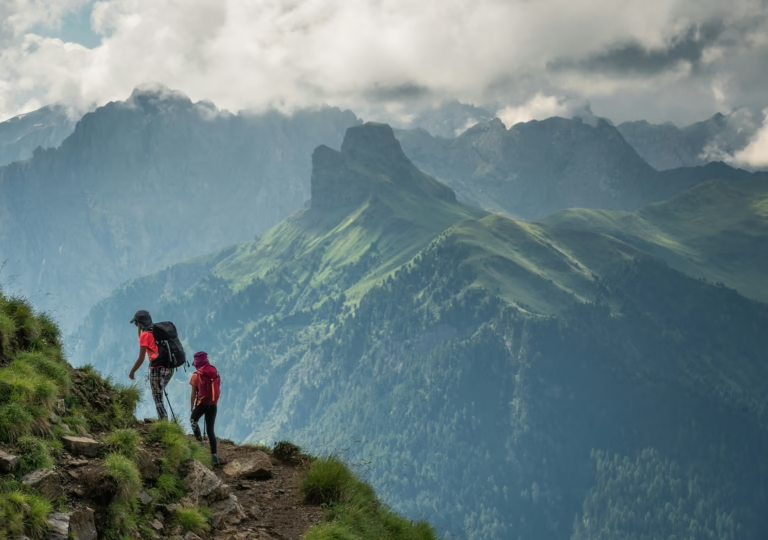Hiking rocks. But sometimes, the same old trails just feel boring. If you want more adventure and a bigger challenge, try rock scrambling. It’s a fun way to make hiking even more exciting.
Did you know that even former US President Theodore Roosevelt used to practice a form of scrambling? Yes, it was popular before we heard about it. [1]
Yet, this activity should not be taken lightly. I couldn’t stress enough how easy it is to get hurt if you don’t choose the right level of difficulty and learn the skills for it. Facts back me up, mentioning several cases of people who died while scrambling due to lack of experience.
What I want to say is “do your homework”. This article will be your guide to this exciting world.
We’ll delve into the different classes of scrambling, understand the key differences between scrambling and bouldering, and equip you with essential rules and tips to ensure a safe and enjoyable experience. Let’s get started!
What Is Rock Scrambling?

Rock scrambling is an outdoor activity where you climb over rocky areas using a mix of walking and climbing moves. It’s like a middle ground between hiking and climbing. You use your hands and feet to balance and move without needing ropes or special gear.
Compared to hiking, rock scrambling typically involves steeper and more challenging terrain, often with loose rocks and uneven surfaces.
How Hard Is It – Classes of Scrambling
The classes of scrambling categorize the difficulty of terrain encountered during a rock scramble. The most commonly used classification system is the Yosemite Decimal System (YDS), which ranges from Class 1 (easy hiking) to Class 5 (technical rock climbing). [2]
Check this system before you go scrambling to understand what class is suitable for you.
Class 1 of Scrambling
Think of this as the gateway drug to the world of scrambles. You’ll encounter loose rocks and uneven terrain, but nothing that requires specialized gear or extensive experience. It’s your typical hike with a few spicy sections thrown in.
Handholds are readily available, and you can maintain three points of contact (two hands and a foot or two feet and a hand) with the terrain without much difficulty.
This is a perfect option for beginners or anyone wanting to dip their toes into the scrambling world.
Pro tip: Don’t underestimate Class 1, especially if you’re new to uneven terrain. Sturdy hiking boots and good balance are your best friends here!
Class 2 of Scrambling
Here, things get a bit more interesting, like a hike with a healthy dose of adventure. You’ll face steeper inclines, loose scree (think pebbles under your feet), and the need to use your hands more frequently for balance.
However, handholds and footholds are still readily available, and exposure (being open to a fall) is minimal. This is where many experienced hikers find their sweet spot, offering a challenge without feeling overwhelming.
Class 3 of Scrambling
Get ready for steeper slopes, exposed sections, and the need for technical skills like stemming (using your body to wedge yourself against the rock) and manteling (pulling yourself over a ledge).
Handholds and footholds may be less obvious, requiring careful route-finding and good judgment.
This is not for the faint of heart, and it’s crucial to have experience with Class 2 scrambles before attempting Class 3.
Class 4 of Scrambling
Entering Class 4 is a serious undertaking. Before you commit, ensure you have proper training, a partner with similar skills, and the necessary equipment.
You’ll encounter near-vertical sections requiring ropes or specialized equipment. Exposure is significant, and the consequences of a fall can be severe.
This is for experienced climbers with the appropriate technical skills and gear.
Class 5 of Scrambling
We are not talking about scrambling anymore; it’s is full-blown rock-climbing territory. You’ll need ropes, harnesses, and specialized climbing gear to navigate vertical rock faces.
This is beyond the scope of this article and requires extensive training and experience.
Scrambling vs Bouldering – Are They the Same?

Bouldering and scrambling are both rock adventures but with distinct flavors.
We’ve answered to question of what is scrambling in hiking – traversing rough terrain using hands and feet. It’s all about flow and continuous movement.
Bouldering, on the other hand, is like rock climbing’s shorter, feistier sibling. You tackle isolated rock formations, focusing on static poses and problem-solving to conquer each “boulder” like a puzzle.
Bouldering often requires specialized shoes and mats, while scrambling sticks to sturdy boots and common sense.
Rules to Follow while Scrambling
You’ve chosen your scrambling adventure – and let me tell you, the thrill is waiting! But before we lace up our boots and hit the trails, let’s talk safety first.
Here are some key rules I follow, to ensure my rock scrambling experiences are epic adventures, not emergencies:
Before you go
1. Know Your Limits, and I Mean Really Know Them
This isn’t just about how many push-ups you can do. Be honest with yourself – how comfortable are you with heights, exposed sections, and technical terrain?
My first Class 3 rock scramble was all about proving myself. I ignored that nagging voice saying, “Maybe this is a bit much,” and ended up clinging to a rock face, heart pounding like a drum solo.
Lesson learned: Listen to your gut and choose scrambles that match your skill and comfort level. Start slow, build your confidence, and the bigger challenges will be there waiting for you.
2. Research the route
Winging it? Not in the mountains, my friend! Choose a rock scramble that fits your abilities, then research the route like a pro. Before every scramble, I grab my favorite guidebook, scour online forums, and even chat with rangers.
The more I know, the more prepared I feel, and the more I can focus on enjoying the experience, not worrying about what’s around the next bend.
3. Buddy Up for Safety and Shared Stoke
Going solo is a recipe for unnecessary risk. Find a partner with similar experience and communication skills – someone you trust and who trusts you.
Let someone else know your plans and expected return time. Because hey, even the most experienced scramblers can have an off day, and having a buddy by your side means you’ve got someone to watch your back (and vice versa).
4. Gear Up Like a Pro (Even if You’re Not)
Sturdy hiking boots with aggressive tread are your best friends on uneven terrain. Consider a helmet, especially for exposed sections where falling rocks are a possibility.
Pack essentials like a navigation tool (map, compass, or GPS – don’t rely solely on your phone!), first-aid kit, warm layers (even in summer!), sun protection, and enough water and food.
Also, long pants and long sleeves might not be the most stylish choice, but they’ll protect you from scrapes, scratches, and pesky insects.
If your chosen scramble involves rappelling or belaying, carry the appropriate equipment like ropes, harnesses, and carabiners.
Bonus Tip: Before you go on a scramble, check the weather forecast religiously before heading out. Bad weather can change the difficulty and safety of a scramble in an instant. Be prepared to turn back if conditions worsen – the mountains will still be there tomorrow, but your safety is paramount.
5. Learn Rope Skills
While not every scramble requires rappelling or belaying, having basic rope handling knowledge is vital for safety. It’s time to talk rope skills!
Master the Basics

- Coiling and uncoiling: It might seem simple, but tangled ropes can be a nightmare on the mountain. Learn proper coiling techniques for smooth rope deployment and easy management.
- Knot tying: Practice essential knots like the figure-eight, double fisherman’s, and prusik knot. These will come in handy for securing yourself, attaching gear, or creating anchors.
- Belaying: If your scramble involves sections where you might need to belay your partner (think steep descents), learn basic belay techniques. Master using a belay device and managing rope slack safely. Your partner’s life might depend on it!
Taking it Up a Notch
Planning a more technical scramble with rappelling or intricate ropework? Here’s what you need:
- Rappelling: Don’t just jump in (literally)! Learn proper rappelling techniques, including body positioning, rope control, and anchor building. Understand different rappel devices and their safe use. Practice makes perfect, so find a safe environment to master this skill before heading to the mountains.
- Anchoring: Secure is the name of the game! Learn how to set up safe anchors using natural features or gear like slings and carabiners. This ensures you have a reliable point for rappelling, belaying, or simply securing yourself.
- Rope management: Juggling multiple ropes can get tricky. Develop skills for rope extension, passing knots, and managing rope drag in technical terrain.
On the scramble
We’ve covered the gear and rope skills, now let’s delve into the heart of the matter: conquering those rocks safely and confidently. Here are some golden rules to guide you on your rock-scrambling adventure:
1. Three Points of Contact

Think of this as your scrambling mantra: always maintain three points of contact with the rock.
This means having at least two hands and a foot, or two feet and a hand, firmly planted on the rock at all times.
Why? Three points provide stability, prevent slips, and give you more control over your movements. Imagine a tripod – the more legs, the sturdier the structure, right? The same principle applies here.
2. Test Before You Trust
Loose rocks are the nemesis of any scrambler. Don’t blindly trust every handhold or foothold. Gently test each one before committing your weight.
Give it a wiggle, a nudge, and see if it feels secure. A loose rock dislodged by you could pose a danger to yourself and others, so be mindful and responsible.
On a scramble last year, I grabbed what seemed like a solid handhold, only to have it crumble in my hand. Thankfully, I maintained two other points of contact and avoided a nasty fall. Lesson learned: trust, but verify!
Related Article: Complete Beginners Guide to Hiking
3. Move Slowly and Deliberately
Rushing on a scramble is like asking for trouble. Take your time, plan your moves deliberately, and be mindful of your surroundings. Think about where you’ll place your next hand or foot, and make sure you have a secure grip before moving on.
4. Communication is Key
Finding a buddy to scramble with isn’t just fun, it’s essential. Stay close, and communicate clearly, especially in exposed sections. Let your partner know your intentions, and be aware of their position and needs.
A simple “heads up” before moving a loose rock or “watch my back” on a tricky step can make all the difference.
5. Know When to Turn Back
Even the most experienced scramblers encounter situations that feel uncomfortable or unsafe. Don’t be afraid to turn back if you feel overwhelmed, encounter unexpected difficulties, or the weather takes a turn for the worse. It’s not giving up; it’s making a smart decision.
Frequently Asked Questions
Yes, you can scramble in hiking boots. They provide good traction and ankle support, making them suitable for navigating rocky terrain. However, for more technical scrambles, specialized climbing shoes might offer better grip and precision.
Hiking involves walking along trails or paths, often in natural environments, without the need for specialized equipment or climbing techniques.
Scrambling, on the other hand, requires navigating rocky terrain using a mix of hiking and climbing moves, often employing hands and feet for balance and progress.
References:
- https://academic.oup.com/whq/article-abstract/52/3/347/6290767
- https://www.masterclass.com/articles/yosemite-decimal-system-explained







